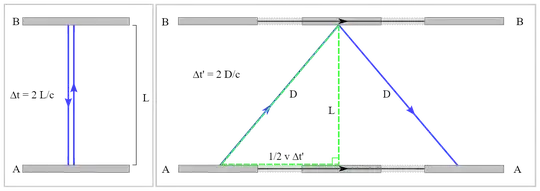Wikipedia states that
a clock that is moving relative to [observer] will be measured to tick slower than a clock that is at rest in their frame of reference
and they explain it using two pictures:
Left: Observer at rest measures time 2L/c between co-local events of light signal generation at A and arrival at A.
Right: Events according to an observer moving to the left of the setup: bottom mirror A when signal is generated at time t'=0, top mirror B when signal gets reflected at time t'=D/c, bottom mirror A when signal returns at time t'=2D/c
Let's assume that the second picture is a train going from left to right. Signal travels perpendicular (90°) to the motion of the train.
Now instead of positioning the mirrors on the floor and ceiling, what if I put mirror A to the back and mirror B to the front of the train (still facing each other). The signal now runs parallel (0° or 180°) to the motion of the train. It travels long way from A to B and short way back to A, effectively cancelling the time dilation effect at the end of the A-B-A trip.
It seems to me that I can tweak the angle between perpendicular (90°) and parallel (0° or 180°) to increase or decrease the time dilation effect.
Now if above is true does it mean that, contrary to what Wiki says, it is possible to position the clock in a way that it will be measured to tick at the same rate (not slower) than a clock that is at rest in observer's frame of reference?
